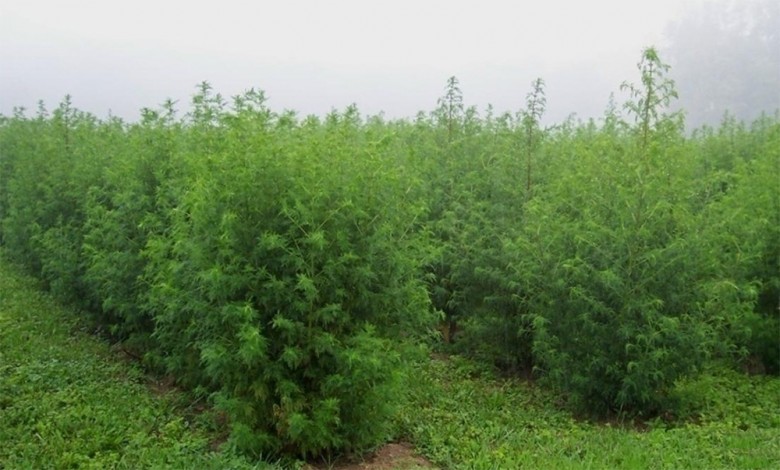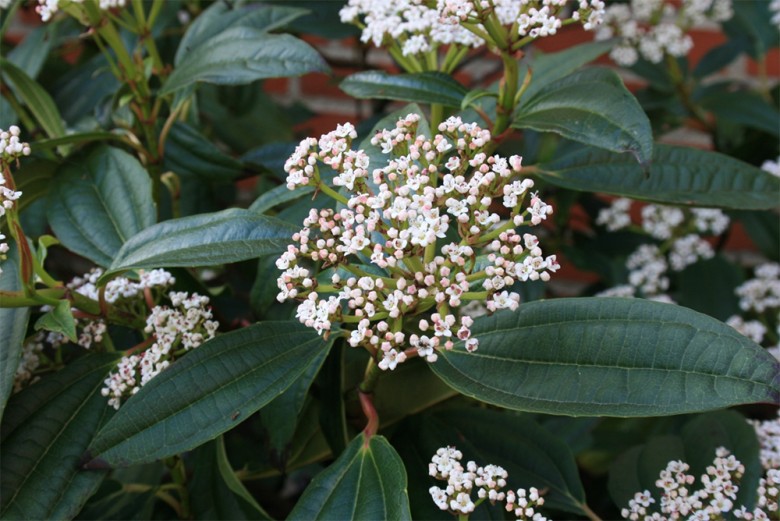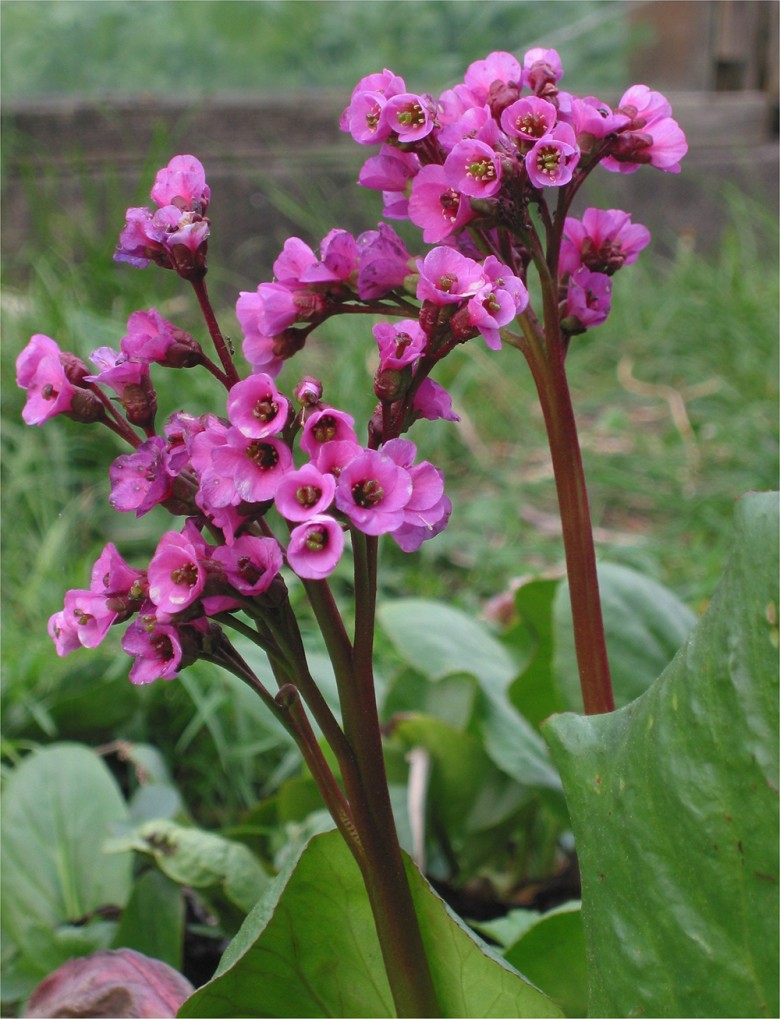-

Winter Garden Foliage
2nd May 2015 • General • Stephanie DonaldsonWhen it comes to gardening it’s often the flowers that grab the attention and almost everyone seems to overlook the foliage. But leaves are the back room boys, the unsung heroes who do all the hard work and let some pretty blossom take all the credit. Ironically, if we gave foliage as much attention as we afford flowers our gardens would probably be a whole lot better. In winter of course, due to the absence of dazzling floral displays, we have a little more time to consider shapes and forms, colours and textures of leaves.
I barely notice the Canary Island ivy, Hedera canariensis ‘Gloire de Marengo’ in summer but the huge silvery green leaves with their creamy white variegations are actually quite dramatic when you see them clothing a sheltered wall in winter.
When designing gardens it’s important that the garden retains a bit of structure even when everything else has died down for the winter. Evergreen plants throughout a garden can act as a skeleton, which can be fleshed out with other plants. Evergreen hedges of Yew or dwarf box can give an otherwise empty bed some shape and make it seem interesting. But what about the colours of things ? Grey plants like Eucalyptus, Senecio and Artemisia tend to be a bit gloomy and lifeless in dull winter light and warmer, richer colours will always work better.
Instead, go for the soft green of the veronica Hebe rakaiensis, the low growing dark green Viburnum davidii and the glossy foliage of Skimmia japonica ’Rubella’ which is as warm as its rich red buds. But it isn’t just fresh green leaves that look good, we shouldn’t ignore the burnt orange leaves of beech hedges that manage to cling on until spring and the brown winter leaves of Polygonum affine ’Superbum’.
Beautiful Conifers
Conifers are far from being my favourite plants, others trees and shrubs come in and out of favour but in my top 100 there is only one conifer that makes the grade; Cryptomeria japonica ‘Elegans’. The wonderfully fluffy, feathery green leaves and the amorphous outline sets it apart from the horrid conical conifers that spring to mind at the very mention of the word. But what sends it soaring up the league table are its autumn and winter hues, when a wonderful warm bronze glow washes over it.
Ignoring other conifers could get me flogged by the National Conifer Society so with that in mind I spare a thought for Chamaecyparis lawsoniana ‘Pembury Blue’ a truly blue specimen which, if I were that way inclined I would definitely have. But you need to be prepared for its height which ultimately exceeds that of two double decker buses. Another good one is the well named Thuja occidentalis ‘Sunkist’ a yellow shrub with young shoot tips flushed a pinky bronze. This is one that is often mistakenly planted as a dwarf for rockeries but actually billows out to a 10ft tree, so beware. The close relative, Thuja orientalis has mid or yellowy green leaves that often turn bronze in winter and like all conifers they make ideal companions for heathers.
There are also prostrate junipers like Juniperus horizontalis which turn a bright violet blue as the cold weather arrives. The best use for these low growing conifers is to hide manhole covers which they’ll do admirably in a couple of years if you plant them with the main shoot pointing in the right direction.
Some evergreen shrubs make a wonderful foil which shows off the plants in front to their best. Phillyrea latifolia is a huge ‘shrub’ as tall as a house whose dark leaves are rivalled only by those of a holly. In spring this much underused giant even has tiny fragrant flowers followed by purplish berries. Any well-drained soil will do but they do like a little protection from cold winds. An even bigger shrub is the female holly Ilex x altaclerensis ‘Camelliifolia’ with it’s thornless camellia like leaves. A backdrop like this can show off coloured stems, lighter foliage, variegated leaves and sculpture to perfection.
Ideal for Winter BloomingWhy?
This evergreen shrub has attractive crinkly edged green leaves and from winter to early spring it’s festooned with pendent grey green catkins 15-20cm long.
Where?
Can be grown as a free standing shrub but often does better with the protection of a wall where it will reach 3 or 4 metres high. Any reasonable soil will do in sun or a bit of shade but plenty of sunshine gives a better display of catkins. They do particularly well in coastal areas.
When?
They get can get damaged by cold winds especially in frost prone areas. If you plant them in late Autumn they may need protecting with horticultural fleece or the leaf edges may get scorched.
History.
Brought back from the Western USA in 1828 by the plant hunter David Douglas it was named after his friend Nicholas Garry. Known as the feverbush, Garrya was used by Native Americans for treating illness.Draining Waterlogged Soils
The winter deluge will have caused a lot of damage to our gardens, but it isn’t so much the flooding itself that’s the problem, it’s the draining away. Prolonged periods of wet means that roots can’t function properly, soil becomes low in important plant nutrients like nitrogen and, as wet soil tends to be cold, plant growth in spring is slow. Eventually, roots, stems and bulbs will rot and lawns turn into mud baths. But even without all this rain, heavy or compacted soils, especially at the bottom of slopes, are prone to waterlogging. Installing some drainage now will sort out your problems before spring and is well worth doing before you embark on any new turfing or planting.- Mark out where the drains are going to be. Ideally there should be a herringbone pattern with the main drains about 5 metres apart. They should drain into either a drainage ditch or a soakaway.
- Dig the trenches about 75 cm deep, the floor of the trench sloping gently and evenly towards the lowest point of the garden. Carefully cut off the turf with a spade and keep it to one side.
- Place a layer of large gravel about 15cm deep into the bottom of the trench and then lay in the pipes. You can use either purpose made perforated plastic piping or butt together clay pipes known as tile drains. Top up the trench and cover the pipes with about another 20cm of gravel.
- Place the cut turfs upside down over the gravel. This stops the soil above from seeping down and clogging the gravel and the drains. Next top up with the remaining topsoil, allow it to settle for a few weeks and then top up as necessary.
- You may need to dig a soakaway to take the excess water bearing in mind that it is illegal to drain it into a property next door. The hole should be about 1.5 metres wide and as much as 2 metres deep. Fill it with hard core, nothing bigger than half a brick. Finish it with a layer of gravel and then a layer of upturned turf and soil. The drainage pipes should enter the soakaway about 60cm below ground level.
- Finally either turf or plant the improved ground. If a soakaway seems like a lot of hard work, consider creating a bog garden instead using plants that will appreciate the excess moisture.
Focus – Seeing the Forest for the Trees
It’s easy to think just of trees and shrubs when considering a winter garden but there are plenty of other plants to choose from.Perennials
The pig root, Sisyrinchium striatum is a clump forming plant with pale grey green iris like leaves growing to about 60cm. It has spikes of soft yellow flowers in summer but the leaves are a real joy. Excess winter wet can be a problem so try planting it in a gravel garden.
Campanula latiloba is usually grown for its rich lavender blue flowers which are last best in shade. As a result the long thin, toothed, green leaves are a good addition for a winter border beneath a deciduous tree but they will also grow well in sun.
Several of the day lilies are officially semi evergreen but our climate change has provoked many, like some Kniphofias, to remain almost totally evergreen all year round. The clump of strap shaped leaves may look a bit tatty on close inspection but at the end of the garden at the front of the border they provide a solid block of fresh green colour. Where space is at a premium they also have the added bonus of summer flowers like the bright red H.’Apple Tart’.
Ferns
The sword fern Polystichum munitum is a beautiful evergreen with eye catching fronds, each frondlet being leathery and untoothed. They form elegant shuttlecocks about 90cm tall and grow in fertile humus rich soil in deep or partial shade. At the end of the winter the old fronds can be cut off as the fresh ones get ready to unfurl.
Blechnum chilense is a fern for an acidic soil that eventually forms a bit of a trunk. Moist, humus rich soil in shade in a woodland setting is ideal where they can happily spread themselves about.
Ground Covers
The lesser periwinkle, Vinca minor is a fairly neat little ground cover with blue or purpley flowers for most of the year but in winter the small dark green leaves are invaluable. There is nothing more miserable than looking at bare soil all winter and this plant will quickly spread sideways in anything but dry soil (some chance) to carpet an area and fill the space between shrubs.
Elephant’s ears, Bergenia cordifolia, are love ‘em or hate ‘em plants. The big green leaves make a brilliant contrast to most plants in the winter garden and can be quite eye catching at the front of a border or as a ground cover. As the frosts begin the cold weather makes the leaves take on a reddish tinge. B.purpurascens has plum purple leaves with red undersides.
The leaves of Cyclamen hederifolium are incredibly varied. Triangular to heart shaped they have intricate silvery patterns on top and are purplish green beneath. They seed freely and quite soon spread to make a carpet of beautiful ground hugging foliage.
 Article supplied by multi-award winning landscape gardener Andy Sturgeon. See more of Andy’s work and list of awards at www.andysturgeon.com.
Article supplied by multi-award winning landscape gardener Andy Sturgeon. See more of Andy’s work and list of awards at www.andysturgeon.com.






























